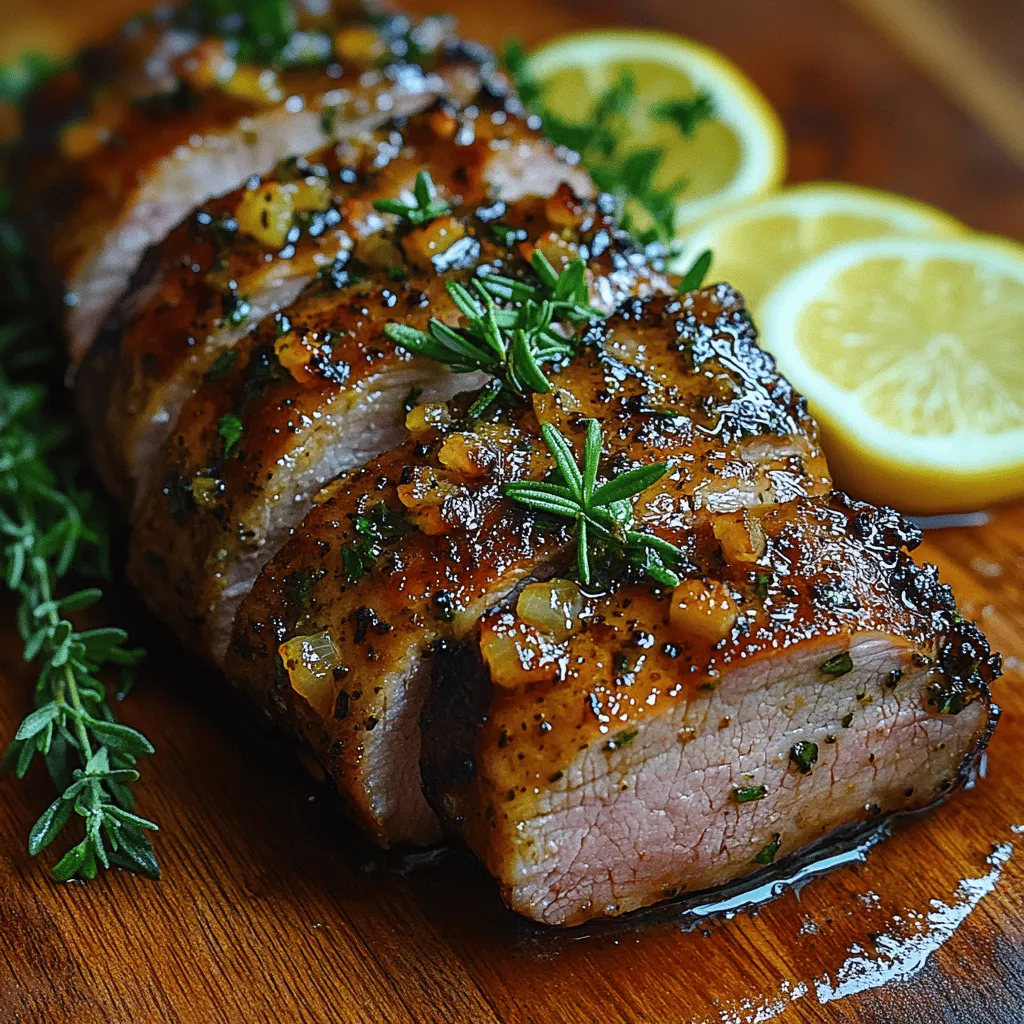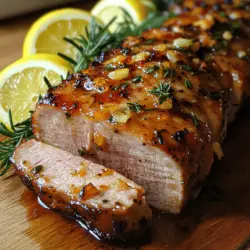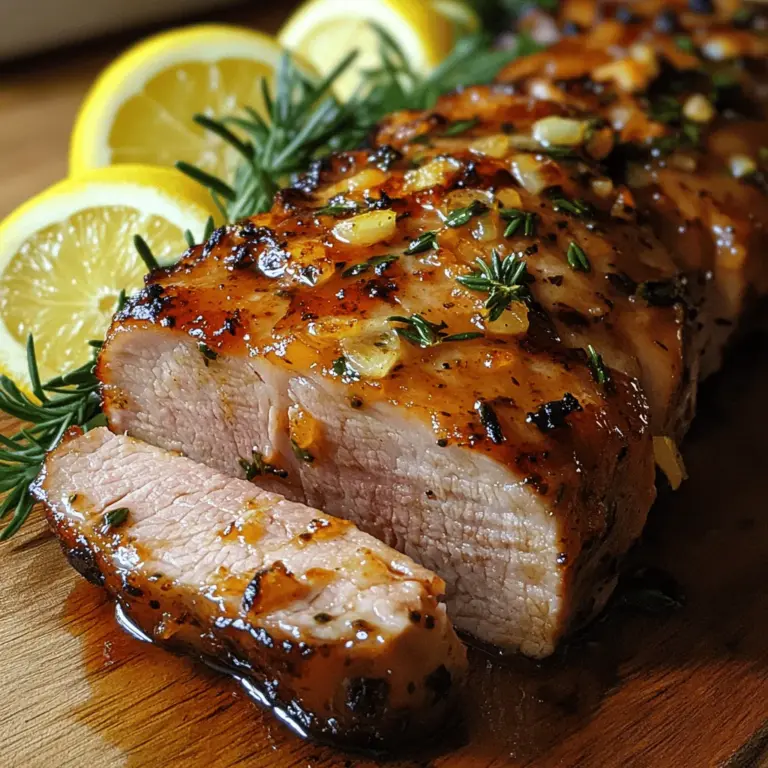Introduction to Savory Garlic Herb Roasted Pork Tenderloin
When it comes to preparing a meal that is both impressive and simple, few dishes can rival the allure of Savory Garlic Herb Roasted Pork Tenderloin. This dish beautifully marries the robust flavors of fresh garlic with the aromatic notes of herbs, creating a culinary experience that delights the senses. Whether you’re hosting a family dinner or celebrating a special occasion, this pork tenderloin recipe is a surefire way to impress your guests and satisfy even the most discerning palates.
The journey to creating this succulent roast begins with understanding the key elements that contribute to its rich flavor and tenderness. By focusing on quality ingredients and proper preparation methods, you can ensure that your pork tenderloin emerges from the oven perfectly cooked and bursting with flavor. Let’s dive into the world of savory garlic herb roasted pork tenderloin, starting with an exploration of this remarkable cut of meat.
Understanding Pork Tenderloin: A Culinary Gem
Pork tenderloin is often hailed as one of the most desirable cuts of pork due to its unique characteristics. This long, narrow cut is taken from the muscle that runs alongside the spine and is renowned for its tenderness and mild flavor. Unlike other cuts of pork, pork tenderloin is exceptionally lean, making it a popular choice for health-conscious eaters looking for a flavorful yet lower-fat option. Its versatility in cooking methods—from grilling to roasting to sautéing—further elevates its status in the culinary world.
One of the standout features of pork tenderloin is its ability to absorb flavors, making it an ideal candidate for marinades. The quick cooking time and lean nature of this cut also mean that it requires careful attention to avoid overcooking, which can lead to dryness. When cooked properly, however, pork tenderloin is incredibly juicy and satisfying, making it a favorite for both weeknight dinners and festive gatherings.
The Importance of Marinating
Marinating is a crucial step in the preparation of pork tenderloin, as it not only enhances the flavor but also improves the tenderness of the meat. The science behind marinating lies in the interaction between the meat and the marinade ingredients. An effective marinade typically contains three key components: acid, fat, and flavor.
The acid—often derived from ingredients like citrus juice, vinegar, or yogurt—works to break down the proteins in the meat, resulting in a more tender final product. The fat, usually in the form of oil, helps to keep the meat moist during cooking while also allowing for better flavor absorption. Finally, the flavoring agents, which can include spices, herbs, and aromatics, infuse the meat with a depth of flavor that makes each bite memorable.
For our Savory Garlic Herb Roasted Pork Tenderloin, we will be utilizing a marinade that combines these elements to create a harmonious balance that complements the pork without overpowering it.
Ingredients Breakdown for the Perfect Marinade
Fresh Garlic: The Flavor Booster
At the heart of our marinade is fresh garlic, a staple in many culinary traditions. Garlic not only provides a robust flavor that enhances the overall dish, but it also boasts numerous health benefits. Rich in antioxidants and known for its anti-inflammatory properties, garlic can contribute to better heart health and immune function. In this recipe, it acts as the primary flavor booster, infusing the pork tenderloin with a savory aroma that will tantalize your taste buds.
Herbs: Rosemary and Thyme
No garlic herb marinade would be complete without the addition of fresh herbs. In this recipe, we’ll be featuring rosemary and thyme, two herbs that are renowned for their aromatic qualities and ability to elevate meat dishes. Rosemary brings a pine-like fragrance that pairs beautifully with pork, while thyme adds a subtle earthiness. Together, they create a fragrant bouquet that complements the richness of the tenderloin, enhancing its natural flavors.
Olive Oil, Dijon Mustard, and Honey: The Flavor Trio
A well-rounded marinade needs a balance of richness, tang, and sweetness, which is precisely what we achieve with olive oil, Dijon mustard, and honey. Olive oil serves as the base of our marinade, providing moisture and a silky texture that coats the pork. Dijon mustard adds a tangy kick and depth of flavor, while honey introduces a hint of sweetness that balances the acidity of the marinade. This trio works in harmony to create a complex flavor profile that enhances the savory elements of the dish.
Seasoning Essentials: Salt, Pepper, and Red Pepper Flakes
Seasoning is a critical component in any recipe, and our pork tenderloin is no exception. Salt and black pepper are essential for bringing out the natural flavors of the meat, while red pepper flakes offer a subtle heat that can be adjusted according to your preference. This combination of seasonings ensures that each bite of the tenderloin is well-rounded and flavorful, making for a truly satisfying meal.
The Zest of Lemon
Finally, we incorporate the zest and juice of fresh lemon into our marinade. The acidity of lemon juice not only brightens the dish but also aids in tenderizing the meat, making it even more succulent. The zesty aroma of lemon adds a refreshing quality that contrasts beautifully with the richness of the olive oil and honey, creating a balanced marinade that enhances the pork tenderloin’s natural flavors.
Step-by-Step Guide to Preparing Savory Garlic Herb Roasted Pork Tenderloin
Now that we’ve covered the essential ingredients for our marinade, let’s dive into the step-by-step process of preparing the Savory Garlic Herb Roasted Pork Tenderloin. The first crucial step is to prepare the marinade itself.
1. Gather Your Ingredients: Start by collecting all the components needed for the marinade—fresh garlic, rosemary, thyme, olive oil, Dijon mustard, honey, lemon juice, salt, black pepper, and red pepper flakes.
2. Mince the Garlic: Take several cloves of fresh garlic and mince them finely. The more finely you chop the garlic, the more flavor it will impart into the marinade.
3. Chop the Herbs: Finely chop the fresh rosemary and thyme. It’s best to use fresh herbs for maximum flavor, though dried herbs can be substituted in a pinch (just use about one-third of the amount).
4. Combine the Marinade Ingredients: In a medium mixing bowl, combine the minced garlic, chopped herbs, olive oil, Dijon mustard, honey, lemon juice, salt, black pepper, and red pepper flakes. Whisk the mixture until all the ingredients are well incorporated. The marinade should be smooth and cohesive.
5. Prepare the Pork Tenderloin: Trim any excess fat or silver skin from the pork tenderloin to ensure even cooking and optimal flavor.
6. Marinate the Pork: Place the pork tenderloin in a resealable plastic bag or a shallow dish. Pour the marinade over the pork, making sure it is evenly coated. Seal the bag or cover the dish, and refrigerate for at least 30 minutes, or ideally, up to 4 hours to allow the flavors to penetrate the meat.
By following these initial steps, you’ll be well on your way to creating a flavorful and tender garlic herb roasted pork tenderloin that will impress your guests and leave a lasting impression. Stay tuned as we continue with the cooking process and tips for achieving the perfect roast.

Creating the Marinade
To begin, let’s focus on crafting a flavorful marinade that will elevate your pork tenderloin. The key to a successful marinade lies in the balance of ingredients and thorough mixing for even flavor distribution. In a medium bowl, combine the following ingredients:
– 1/4 cup olive oil
– 4 cloves garlic, minced
– 1 tablespoon fresh rosemary, chopped
– 1 tablespoon fresh thyme, chopped
– 1 tablespoon Dijon mustard
– 2 tablespoons balsamic vinegar
– Salt and pepper to taste
Whisk the ingredients together until they are well combined and emulsified. This thorough mixing is crucial as it ensures that the garlic, herbs, and spices are evenly distributed throughout the oil, allowing for maximum flavor infusion into the pork tenderloin. The olive oil acts as a carrier for the flavors, while the acidity from the balsamic vinegar tenderizes the meat.
Marinating the Pork Tenderloin
Once your marinade is ready, it’s time to turn your attention to the pork tenderloin. Place the cleaned and trimmed pork tenderloin into a resealable plastic bag or a shallow dish. Pour the marinade over the pork, ensuring that it is fully coated. Seal the bag or cover the dish and refrigerate.
For optimal flavor infusion, marinate the pork tenderloin for at least 1 hour, though 4 to 6 hours is ideal. If you have time, letting it marinate overnight will yield even more robust flavors. The longer the pork sits in the marinade, the deeper the flavors will penetrate the meat, resulting in a juicy and aromatic dish.
Prepping for Roasting
Before roasting, it’s essential to prepare your oven and baking dish properly. Preheat your oven to 400°F (200°C). This temperature is perfect for achieving a beautifully caramelized exterior while keeping the inside tender and juicy.
When selecting your baking dish, consider using a roasting rack placed inside a sheet pan. The roasting rack allows hot air to circulate around the pork, promoting even cooking and browning. Additionally, lining the baking dish with aluminum foil makes for easy cleanup, especially if any drippings occur during the roasting process.
Roasting Techniques for Perfect Results
With the pork marinated and the oven preheated, it’s time to roast the tenderloin. Remove the pork from the marinade, allowing any excess to drip off before placing it on the roasting rack. Discard the leftover marinade, as it has come into contact with raw meat.
Roast the pork tenderloin in the preheated oven for about 25 to 30 minutes, or until the internal temperature reaches 145°F (63°C). This temperature ensures that the pork is cooked through while remaining juicy. To check for doneness, use an instant-read thermometer inserted into the thickest part of the meat. Avoid touching any bones, as this may give you an inaccurate reading.
Basting for Moisture and Flavor
Basting the pork tenderloin during the roasting process can significantly enhance both moisture and flavor. About halfway through the roasting time, carefully spoon some of the pan juices over the pork. This technique not only adds additional flavor but also helps to keep the meat moist and prevents it from drying out. If you have a baster, it’s an excellent tool for this task.
Continue roasting until the pork reaches the desired internal temperature. If you find that the meat is browning too quickly, tent it loosely with aluminum foil to prevent over-browning while it finishes cooking.
Resting the Meat: Why It Matters
After removing the pork tenderloin from the oven, it’s crucial to let it rest for at least 10 minutes. Resting allows the juices to redistribute throughout the meat, which contributes to its overall juiciness and tenderness. If you cut into the pork immediately after cooking, the juices will run out, leaving you with a drier result.
Cover the tenderloin loosely with foil during the resting period to keep it warm. This step is essential for achieving the best texture and flavor, ensuring that each slice is succulent and satisfying.
Serving Suggestions and Pairings
Slicing and Plating the Pork Tenderloin
When it’s time to serve your savory garlic herb roasted pork tenderloin, proper slicing is key. Use a sharp carving knife to slice the tenderloin into 1/2-inch thick medallions. This thickness allows for a beautiful presentation and ensures that each piece remains juicy. Arrange the slices on a serving platter, slightly overlapping them for an attractive display.
Ideal Side Dishes to Complement the Pork
To create a well-rounded meal, pair your roasted pork tenderloin with side dishes that enhance the flavors of the dish. Consider serving it alongside:
– Roasted Vegetables: Seasonal vegetables such as carrots, Brussels sprouts, and sweet potatoes, tossed in olive oil and herbs, make a colorful and nutritious accompaniment.
– Creamy Mashed Potatoes: The rich and buttery flavor of mashed potatoes contrasts beautifully with the savory pork, making it a classic pairing.
– Garlic Green Beans: Sautéed green beans with a hint of garlic add a fresh, crisp element to the plate.
These sides not only complement the tenderloin but also add a variety of textures and flavors to your meal.
Garnishing for Visual Appeal
To elevate your dish’s presentation, garnish the sliced pork tenderloin with fresh herbs, such as rosemary or thyme, and lemon slices. The bright yellow of the lemon adds a pop of color and a touch of acidity that can brighten the flavors of the dish. A sprinkle of freshly cracked black pepper or a drizzle of balsamic reduction can also enhance the visual appeal while providing additional flavor.
Conclusion: Enjoying Your Savory Garlic Herb Roasted Pork Tenderloin
In conclusion, the savory garlic herb roasted pork tenderloin is a delightful dish that marries rich flavors with tender, juicy meat. The combination of garlic and fresh herbs creates a mouthwatering aroma that will entice anyone to the dinner table. With its straightforward preparation and the use of fresh ingredients, this recipe is perfect for both casual family dinners and special occasions.
By following the steps outlined in this recipe, you can create a stunning and delicious centerpiece that will impress your guests. Embrace the joys of cooking, explore new flavors, and savor the experience of sharing this delectable dish with your loved ones. Whether served with roasted vegetables, creamy mashed potatoes, or a simple green salad, this pork tenderloin is sure to become a favorite in your culinary repertoire. Enjoy every moment and every bite!

